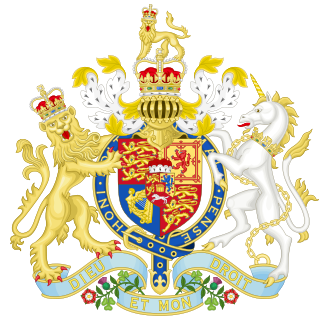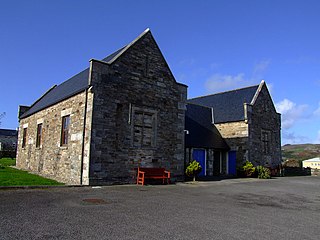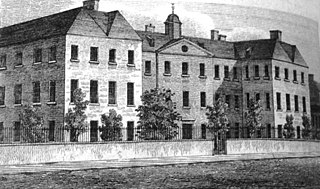Related Research Articles

The English Poor Laws were a system of poor relief in England and Wales that developed out of the codification of late-medieval and Tudor-era laws in 1587–1598. The system continued until the modern welfare state emerged after the Second World War.

In Britain and Ireland, a workhouse was an institution where those unable to support themselves financially were offered accommodation and employment. The earliest known use of the term workhouse is from 1631, in an account by the mayor of Abingdon reporting that "we have erected wthn [sic] our borough a workhouse to set poorer people to work".
A poorhouse or workhouse is a government-run facility to support and provide housing for the dependent or needy.
A vestry was a committee for the local secular and ecclesiastical government of a parish in England, Wales and some English colonies, which originally met in the vestry or sacristy of the parish church, and consequently became known colloquially as the "vestry". At their height, the vestries were the only form of local government in many places and spent nearly one-fifth of the budget of the British government. They were stripped of their secular functions in 1894 and were abolished in 1921.

The Poor Law Amendment Act 1834 (PLAA) known widely as the New Poor Law, was an Act of the Parliament of the United Kingdom passed by the Whig government of Earl Grey. It completely replaced earlier legislation based on the Poor Relief Act 1601 and attempted to fundamentally change the poverty relief system in England and Wales. It resulted from the 1832 Royal Commission into the Operation of the Poor Laws, which included Edwin Chadwick, John Bird Sumner and Nassau William Senior. Chadwick was dissatisfied with the law that resulted from his report. The Act was passed two years after the Representation of the People Act 1832 which extended the franchise to middle-class men. Some historians have argued that this was a major factor in the PLAA being passed.
A poor law union was a geographical territory, and early local government unit, in Great Britain and Ireland.

In England and Wales, an extra-parochial area, extra-parochial place or extra-parochial district was a geographically defined area considered to be outside any ecclesiastical or civil parish. Anomalies in the parochial system meant they had no church or clergymen and were therefore exempt from payment of poor or church rates and usually tithes. They were formed for a variety of reasons, often because an area was unpopulated or unsuitable for agriculture, but also around institutions and buildings or natural resources. Extra-parochial areas caused considerable problems when they became inhabited as they did not provide religious facilities, local governance or provide for the relief of the poor. Their status was often ambiguous and there was demand for extra-parochial areas to operate more like parishes. Following the introduction of the New Poor Law, extra-parochial areas were effectively made civil parishes by the Extra-Parochial Places Act 1857 and were eliminated by the Poor Law Amendment Act 1868. This was achieved either by being integrated with a neighbouring or surrounding parish, or by becoming a separate civil parish if the population was high enough.

The Andover workhouse scandal of the mid-1840s exposed serious defects in the administration of the English 'New Poor Law'. It led to significant changes in its central supervision and to increased parliamentary scrutiny. The scandal began with the revelation in August 1845 that inmates of the workhouse in Andover, Hampshire, England were driven by hunger to eat the marrow and gristle from bones which they were to crush to make fertilizer. The inmates' rations set by the local Poor Law guardians were less than the subsistence diet decreed by the central Poor Law Commission (PLC), and the master of the workhouse was diverting some of the funds, or the rations, for private gain. The guardians were loath to lose the services of the master, despite this and despite allegations of the master's drunkenness on duty and sexual abuse of female inmates. The commission eventually exercised its power to order dismissal of the master, after ordering two enquiries by an assistant-commissioner subject to a conflict of interest; the conduct of the second, more public inquiry drew criticism.

The Poor Relief Act 1601 was an Act of the Parliament of England. The Act for the Relief of the Poor 1601, popularly known as the Elizabethan Poor Law, "43rd Elizabeth" or the Old Poor Law was passed in 1601 and created a poor law system for England and Wales.

The Relief of the Poor Act 1782, also known as Gilbert's Act, was a British poor relief law proposed by Thomas Gilbert which aimed to organise poor relief on a county basis, counties being organised into parishes which could set up poorhouses or workhouses between them. However, these workhouses were intended to help only the elderly, sick and orphaned, not the able-bodied poor. The sick, elderly and infirm were cared for in poorhouses whereas the able-bodied poor were provided with poor relief in their own homes. Gilbert's Act aimed to be more humane than the previous modification to the Poor Law, the Workhouse Test Act. During the 1780s, there was an increase in unemployment and underemployment due to high food prices, low wages and the effects of enclosing land. This caused poor rates to increase rapidly, which wealthy landowners found unacceptable.

In English and British history, poor relief refers to government and ecclesiastical action to relieve poverty. Over the centuries, various authorities have needed to decide whose poverty deserves relief and also who should bear the cost of helping the poor. Alongside ever-changing attitudes towards poverty, many methods have been attempted to answer these questions. Since the early 16th century legislation on poverty enacted by the Parliament of England, poor relief has developed from being little more than a systematic means of punishment into a complex system of government-funded support and protection, especially following the creation in the 1940s of the welfare state. Poor relief will control crime if adequately given.
From the reign of Elizabeth I until the passage of the Poor Law Amendment Act 1834 relief of the poor in England was administered on the basis of a Poor Relief Act 1601. From the start of the nineteenth century the basic concept of providing poor relief was criticised as misguided by leading political economists and in southern agricultural counties the burden of poor-rates was felt to be excessive (especially where poor-rates were used to supplement low wages. Opposition to the Elizabethan Poor Law led to a Royal Commission on poor relief, which recommended that poor relief could not in the short term be abolished; however it should be curtailed, and administered on such terms that none but the desperate would claim it. Relief should only be administered in workhouses, whose inhabitants were to be confined, 'classified' and segregated. The Poor Law Amendment Act 1834 allowed these changes to be implemented by a Poor Law Commission largely unaccountable to Parliament. The act was passed by large majorities in Parliament, but the regime it was intended to bring about was denounced by its critics as un-Christian, un-English, unconstitutional, and impracticable for the great manufacturing districts of Northern England. The Act itself did not introduce the regime, but introduced a framework by which it might easily be brought in.
Boards of Guardians were ad hoc authorities that administered Poor Law in the United Kingdom from 1835 to 1930.

A chapelry was a subdivision of an ecclesiastical parish in England and parts of Lowland Scotland up to the mid 19th century.

Business rates is the commonly used name of Non-Domestic Rates in Scotland, a tax on occupation of non-domestic property. Rates are a property tax used to fund local services that dates back to the Poor Law.

The Irish poor laws were a series of acts of Parliament intended to address social instability due to widespread and persistent poverty in Ireland. While some legislation had been introduced by the pre-Union Parliament of Ireland prior to the Act of Union, the most radical and comprehensive attempt was the Irish act of 1838, closely modelled on the English Poor Law Amendment Act 1834. In England, this replaced Elizabethan era legislation which had no equivalent in Ireland.

The Poor Law (Scotland) Act 1845 was an Act of Parliament that reformed the Poor Law system of Scotland.

A House of Industry was a workhouse in Dublin, Ireland which existed from its establishment by an act of parliament in 1703, "for the employment and maintaining the poor thereof."

The Old Scottish Poor Law was the Poor Law system of Scotland between 1574 and 1845.

The Scottish poorhouse, occasionally referred to as a workhouse, provided accommodation for the destitute and poor in Scotland. The term poorhouse was almost invariably used to describe the institutions in that country, as unlike the regime in their workhouse counterparts in neighbouring England and Wales residents were not usually required to labour in return for their upkeep.
References
- ↑ "Workhouse - the Story of Workhouses". users.ox.ac.uk. Archived from the original on 17 February 2001. Retrieved 30 June 2022.
- ↑ "Workhouse - the Story of Workhouses". users.ox.ac.uk. Archived from the original on 17 February 2001. Retrieved 30 June 2022.
- ↑ "British social policy 1601-1948". Archived from the original on 20 July 2007. Retrieved 17 May 2009.
- ↑ In Scotland the more common term for a workhouse was "poorhouse"
- ↑ "Workhouse - the Story of Workhouses". users.ox.ac.uk. Archived from the original on 17 February 2001. Retrieved 30 June 2022.
- ↑ "Workhouse - the Story of Workhouses". users.ox.ac.uk. Archived from the original on 17 February 2001. Retrieved 30 June 2022.
- ↑ "Workhouse - the Story of Workhouses". users.ox.ac.uk. Archived from the original on 17 February 2001. Retrieved 30 June 2022.
- ↑ "Workhouse - the Story of Workhouses". users.ox.ac.uk. Archived from the original on 17 February 2001. Retrieved 30 June 2022.
- ↑ "Knowledge Base - The Poor Law in Scotland After 1845". Scan.org.uk. Retrieved 2 February 2020.
- ↑ BBC - History - Beneath the Surface: A Country of Two Nations
- ↑ Video Interview at the Mitchell Library with Dr. Irene O'Brien, showing an example of a poor law application (February 2008)
